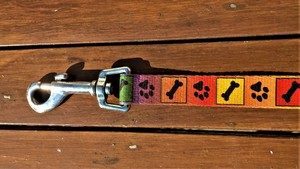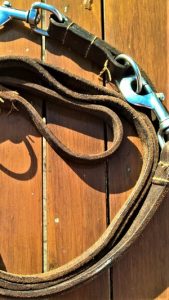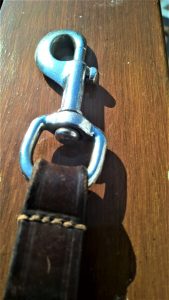Dog Leads – Choosing The Best For Your Dog.
Here is a little secret of mine. I don’t collect shoes or handbags – but I do find it difficult to tear myself away from the dog lead aisle in pet shops. I love the array of different textures and colours of dog leads – vibrantly displayed and to be deliberated over like one might choose a new outfit.
It might be argued, that one dog lead is just as good as another. To a certain extent, that’s true, but sometimes, certain types of lead suit different types of dogs better, depending on their temperament, size and breed.
Of course, a dog lead – whatever the type – is there to keep your dog under control and safe when he is out and about in public. But, if you’re like me, you want your dog to look nice and smart too!
For reasons of safety, your dog must legally be under control in public spaces, so choosing the right lead is important. A lead is an essential tool for training sessions, as well as day-to-day activities.
A good sturdy lead prevents your dog from causing an accident and stops him from chasing other animals, dogs, or people. Additionally, a lead ensures he is also toileting where he should.
When your dog stays with one of our Holidays4Dogs carers, you must provide a suitable, sturdy lead. Please check the lead is in good condition before your dog’s stay. Your dog must also have a well-fitting collar and harness if you use one.
A standard dog lead is usually between 4 and 6 feet long with differing widths. They can be made of leather, nylon, or rope.
 Nylon leads are lightweight but tough enough to restrain even the largest breeds. Do be aware, however, that they are quite easy to chew through. Nylon is a good choice for wet weather walking, as it dries out quickly.
Nylon leads are lightweight but tough enough to restrain even the largest breeds. Do be aware, however, that they are quite easy to chew through. Nylon is a good choice for wet weather walking, as it dries out quickly.
Leather leads are robust. but again, they can often be attractive to dogs that like to chew. Leather will need more care, especially after a walk in the rain. That said, they are likely to last a lifetime.
Choosing the right width of lead is important too; you need it to be strong  enough to restrain your dog without restricting him, or her.
enough to restrain your dog without restricting him, or her.
A young puppy doesn’t need a lead that is too thick and heavy. Therefore, start with a smaller, lighter lead until the puppy grows – (and start a collection like me!).
The style of the clip is also a consideration since they do vary in type and, significantly, quality. Clips made of stainless steel, or brass, are by far the best choice as they don’t tend to corrode as quickly.
I have noticed that dog leads in high street supermarkets, or cheaper outlets, do not always have good-quality clips, so this is something to look out for.
Cheap clips are apt to fail when they become wet over time, (particularly in seawater). It is common for them to either become stuck on the ‘open’ setting, (allowing your dog to escape) or, become impossible to unlock.
 Trigger hook clips are the most common. Inside, there is a spring mechanism which is operated by the pull-back trigger. Always check these regularly, as springs can weaken and fail over time.
Trigger hook clips are the most common. Inside, there is a spring mechanism which is operated by the pull-back trigger. Always check these regularly, as springs can weaken and fail over time.
Some leads are adjustable in length by using one, or two, rings located along the length. Adjustable dog leads are handy, especially when it comes to training. They can either be set shorter, or longer, depending on the circumstances. These types of dog leads are usually made of leather or nylon.
Retractable, or extending, leads are the choice for many. However, do be aware of the pitfalls including; tripping, ‘rope burns’ and other accidents, which may compromise the safety of your dog or others around you.
Extending leads is more appropriate for open spaces. The handles of retractable leads are cumbersome to hold, especially on the short setting and can easily be accidentally dropped.
Many people, including myself, prefer long lines. Once you get the hang of using a long line, they give your dog more freedom. They are also good for training recall.
If your dog pulls strongly on the lead, always attach it to a harness rather than a collar. Leads attached to neck collars can cause the dog discomfort and injury.
Do you often buy leads, or do you have one or more old faithful that have seen you through lots of dogs? Let us know on our Facebook or Instagram pages.
Holidays4dogs.co.uk and 4Dogs are participants in the Amazon Services LLC Associates Program, an affiliate advertising program designed to provide a means for sites to earn commission fees by advertising and linking to the following websites. Read our full disclosure agreement here.


